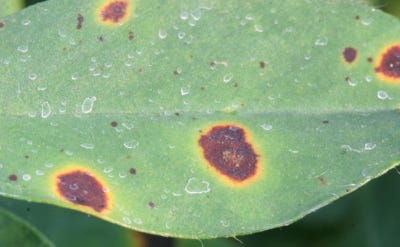
Fungicides work primarily as a preventive, says Alan Henn, Mississippi State University Extension professor of entomology and plant pathology, who spoke at the annual meeting of the Mississippi Peanut Growers Association. “Once you have a disease, it’s a lot harder to manage than if you head it off with a proper application of fungicide.”

Fungicides are a key component in a successful peanut production program, says Alan Henn, Mississippi State University Extension professor of entomology and plant pathology, and growers should seek to optimize use of these materials in order to hold the line on costs.

ALAN HENN
“You need to make judicious applications of fungicides when they’re needed to prevent and control diseases,” he said at the annual meeting of the Mississippi Peanut Growers Association.
To do that, growers should:
• “Set really clear boundaries about what to expect and what expenses you might have.
• Do your best budgeting ahead of time.
• Make sure you carefully select fields to be planted to peanuts.
• “Remember, you want to follow a three-year rotation — and soybeans, also a legume crop, shouldn’t be used.”
• Know the disease history of your fields.
• Where possible, use the Peanut Rx program to select fields that may be suited to a reduced number of fungicide applications. “It’s a really helpful tool. If you have questions about how to use it, give me a call and I’ll be happy to help you.”
• Work collaboratively with the person who scouts your fields to anticipate problems that may arise. “You need to be talking together all the time about the what, when, and how of your fungicide program.”
When and what to spray should be tailored to the individual situation, Henn says. “Phoning your neighbor up the road or down the road from your farm isn’t the way to determine this, because most of the time what’s going on in one production area doesn’t necessarily relate to what’s going on in another.”
Fungicides work primarily as a preventive, he notes. “Once you have a disease, it’s a lot harder to manage than if you head it off with a proper application of fungicide.”
In areas that have been producing peanuts for a number of years, as in Georgia and Alabama, Henn says producers and researchers have developed a conventional spray schedule. “Basically, it’s 30 days after planting for your first application, then every 15 days until harvest — seven fungicide applications for the production cycle.
“Weather is the key to peanut diseases, and they are heavily modified by climatic conditions. They’re worse in hot, humid, moist weather than in dry conditions.”
The NOAA long-term prediction for 2013 is for above average temperatures in Mississippi during the growing season, and equal chances for above normal, below normal, or normal precipitation through July, Henn says. “Beyond July, NOAA is saying there are above normal chances for rains August through October, when we’re most likely to have tropical storms and wet systems coming off the Gulf. “
Early and late leaf spots, major problems in neighboring Alabama and in Georgia, have thus far not been a problem in Mississippi, he says. Rather, last year the state’s growers were mostly troubled by funky leaf spot and leaf scorch.
“Those infections, for the most part, come from overwintering disease material and are in the field when peanuts come up the following year. Mississippi growers have been practicing really good rotations, which has helped to avoid a lot of leafs pot pressure and has saved a lot of money.”
Both early and late leaf spot were found in Mississippi in 2011 and 2012, Henn says, “but they were late in the season and just like Asian soybean rust, using the same ASR models, I’ve been able to link incidences to tropical storms moving up out of the Yucatan peninsula and over Texas, picking up disease spores from their peanut fields and raining them onto our fields
“About 20 days after a major rain event, you may see depressed, yellowing areas in fields due to leaf spots. Three days later, the spots will have spread more — these diseases are somewhat aggressive.”
A close examination, he says, shows the leaf spots to be “much darker than funky leaf spot, leaf scorch, and other leaf spots we’ve seen in Mississippi. If you have these rainstorm-related leaf spots, you’re going to need tobe on a regular fungicide application schedule.
Monitor storm fronts closely
“Watch these southern storm fronts closely, particularly since NOAA is predicting increased rainfall in August and September. I’d suggest planning for a couple of preventive applications before a storm comes in so peanut leaves are protected if rain-borne spores fall on your peanut crop.

WHITE MOLD is among the diseases peanut growers combat with an effective fungicide program.
“I’m not suggesting anything fancy — just straight tebuconazole plus Echo or Bravo. Remember, Bravo is just like a raincoat — it protects the part of the plant it covers. And just like a little kid outgrowing his raincoat, as plants continue to grow more area is exposed. The tebuconazole adds a little extra protection in case you can’t get into the fields right away after the rain. I’d suggest a final preventive chlorothalonilapplication. The cost for these applications is about $41 per acre.”
He says he hasn’t seen as much of a problem from Rhizoctonia in Mississippi as expected, “but I have seen significant problems with southern stem rot/southern blight in most peanut production areas. This is one reason you need to choose your fields carefully, to reduce potential for disease before you even plant. Fungicide use to control this disease can boost yield as much as 10 percent.”
White mold rots the plant, cutting off its water uptake, he says. “It attacks the nuts and reduces quality as well as yield. It also produces resting sclerotial structures, which can last in the soil for three years — which is why you need to have long rotations. This disease seems to occur early season on plants in warmer than normal weather.”
Growers should stay away from fields with a history of southern stem rot/southern blight, Henn says, and if it’s necessary to plant in a field with southern stem rot history, “consider an early fungicide application somewhere around 15 days after planting, or a bit later. This will increase your fungicide budget. And if you are planting in such a field this year, I’d like to work with you on small plot studies for early application of fungicides to head off this disease.”
For the conventional seven-application fungicide system, Henn says, cost per acre could range from $130 to $160, based on use of a 350-450 gallon self-propelled sprayer with a 60-foot boom, costing about $103,000, and current fungicide prices and label rate.
“This is based on the assumption that there’s not a lot of disease pressure, that we make all applications as cheaply as possible, that for the first, second, fourth, and seventh application we use a tank mix of generic tebuconazole and a chlorothalonilmaterial such as Bravo or Echo, and a seventh application of chlorothalonil alone.”
Controlling leaf spots
Early leaf spot spread can be controlled with a regular fungicide application program, Henn says. “This is one of the diseases that has forced adoption of calendar spray programs in Georgia and Alabama. It is manageable disease — but it is not one to be ignored.

REGULAR FUNGICIDE applications can help control early leaf spot.
“Scouting of fields and appropriate fungicide sprays will prevent loss. Chlorothalonil fungicides (Bravo, Echo and others) protect the leaf surface against new infections, whereas some of the penetrant-type fungicides that enter plant parts near the droplet have some ‘curative’ activity — they can kill the fungus after it has infected plants, but before it spreads.
“Fungicides include but are not limited to Headline, Provost, and Tebuzole. They have little activity against infections already present, and all start losing activity 7-10 days after application. You can improve how well all fungicides work by increasing spray volume; 20 gallons to 30 gallons per acre will be more effective than 15 gallons per acre.
“If a field already has significant defoliation, early leaf spot is common on the remaining leaves, and the crop is approaching maturity, as judged by color and number of the blasted nuts, you may chose to dig affected fields first.”
Funky leaf spot
There is no identified cause of funky leaf spot, also called Florida leaf spot and irregular leaf spot, Henn says. “Extensive laboratory examination of FLS symptoms has yet to find a cause, bacterial or fungal. Leaf symptoms look very much like leaf scorch.
“FLS leaf symptoms are common on lower plant leaves and are most common during the earlier part of the season, before the plant really gets into reproductive growth. There may be a greater incidence in fields with reduced tillage or residue amounts. I’ve noted that FLS is more common in areas where moisture stays on the leaves longer, as on the eastern side of the field near trees, or where an upper leaf touches a lower leaf, and where a plants are already stressed.”
No clear association between FLS and yield has been established, Henn says. “Defoliation can be high in some older cultivars, but I have yet to see a serious defoliation problem in Georgia 06 G.
“A number of people have looked at applying fungicides for control of FLS, with no effect. Save your money and fungicides — don’t try to control this leaf spot; it will disappear on its own.”
Leaf scorch/pepper spot
A fungus, Leptosphaerulina crassiasca, can cause two different disease symptoms on peanut leaflets — leaf scorch and pepper spot, Henn notes. “Both symptoms produce only minor plant problems (slight defoliation), and by themselves are not worth spraying. Sprays that are targeted to other problems will almost inevitably control this fungus.”
Leaf Scorch is the most common symptom produced by the fungus in Mississippi, he says.
Pepper spot, also caused by the fungus, is identified by small (about 1 mm) black spots on the upper side of the leaf that grow slowly.
Peanut Rx program
Mississippi growers may be able to reduce fungicide costs over the conventional program by using the Peanut Rx Program that was developed by researchers in Georgia, Alabama, and Florida.
“This program has proven successful in those areas for several years, and some growers in Mississippi are trying it on their farms,” Henn says.
Compared to the conventional fungicide system cost of $130 to $160 per acre, costs using the Peanut Rx program are about $96, Henn says.
The program uses field history, variety, rotation, and other factors to determine the risk of infection from a particular disease. After risk has been assessed, a prescription fungicide recommendation can then be developed.
“Because of the relative newness of peanuts in Mississippi, disease inoculums should be low in many areas of the state,” he says.
In Mississippi studies, leaf spot applications were made at 45 and 105 days after emergence, and white mold applications were made at 75 days after application.
“The number of fungicide applications was reduced from seven in the standard program to three in the Peanut Rx program, at a cost savings of approximately $70 per acre,” Henn says. “This represents a significant reduction in fungicide program cost and should give Mississippi producers a competitive advantage, provided the system is not misused. Rotation is critical to reducing disease inoculum.
“There are also newer varieties available that can provide higher yield potential and disease resistance as well. By incorporating these newer varieties into the Peanut Rx program, Mississippi growers may be able to even further reduce the need for fungicides,” Henn says.
You might also read:
A buyer’s market for urea?
About the Author(s)
You May Also Like



